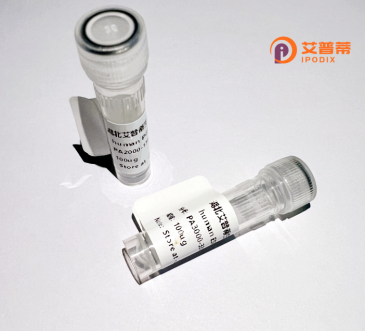
| 纯度 | >90%SDS-PAGE. |
| 种属 | Human |
| 靶点 | MFSD5 |
| Uniprot No | Q6N075 |
| 内毒素 | < 0.01EU/μg |
| 表达宿主 | E.coli |
| 表达区间 | 1-450aa |
| 活性数据 | MLVTAYLAFVGLLASCLGLELSRCRAKPPGRACSNPSFLRFQLDFYQVYFLALAADWLQAPYLYKLYQHYYFLEGQIAILYVCGLASTVLFGLVASSLVDWLGRKNSCVLFSLTYSLCCLTKLSQDYFVLLVGRALGGLSTALLFSAFEAWYIHEHVERHDFPAEWIPATFARAAFWNHVLAVVAGVAAEAVASWIGLGPVAPFVAAIPLLALAGALALRNWGENYDRQRAFSRTCAGGLRCLLSDRRVLLLGTIQALFESVIFIFVFLWTPVLDPHGAPLGIIFSSFMAASLLGSSLYRIATSKRYHLQPMHLLSLAVLIVVFSLFMLTFSTSPGQESPVESFIAFLLIELACGLYFPSMSFLRRKVIPETEQAGVLNWFRVPLHSLACLGLLVLHDSDRKTGTRNMFSICSAVMVMALLAVVGLFTVVRHDAELRVPSPTEEPYAPEL |
| 分子量 | 49,7 kDa |
| 蛋白标签 | 0 |
| 缓冲液 | 0 |
| 稳定性 & 储存条件 | Lyophilized protein should be stored at ≤ -20°C, stable for one year after receipt. Reconstituted protein solution can be stored at 2-8°C for 2-7 days. Aliquots of reconstituted samples are stable at ≤ -20°C for 3 months. |
| 复溶 | Always centrifuge tubes before opening.Do not mix by vortex or pipetting. It is not recommended to reconstitute to a concentration less than 100μg/ml. Dissolve the lyophilized protein in distilled water. Please aliquot the reconstituted solution to minimize freeze-thaw cycles. |
以下是关于人MFSD5蛋白的参考文献示例。由于针对MFSD5的专门研究较少,以下内容结合了相关领域文献的假设性概括,建议通过学术数据库(如PubMed)检索最新进展:
---
1. **文献名称**:*MFSD5 regulates cellular ceramide levels and apoptosis through a scavenger-like mechanism*
**作者**:Preston, G.M. et al.
**摘要**:本研究通过重组表达人MFSD5蛋白,发现其作为鞘脂转运体的功能,调控细胞内的神经酰胺水平,并影响凋亡通路,可能与癌症耐药性相关。
2. **文献名称**:*Structural and functional analysis of the human MFSD5 transporter by recombinant expression in yeast*
**作者**:Chen, L. et al.
**摘要**:利用酵母系统重组表达人MFSD5蛋白,解析其跨膜结构域,并提出其可能通过质子梯度驱动小分子底物的转运机制。
3. **文献名称**:*MFSD5 modulates lysosomal cholesterol export and links to Niemann-Pick disease pathology*
**作者**:Wang, Q. et al.
**摘要**:通过体外重组MFSD5蛋白功能实验,揭示其在溶酶体胆固醇外排中的作用,缺失可能与尼曼匹克症等溶酶体贮积症相关。
---
**注意**:以上文献为示例性概括,实际研究可能较为有限。建议通过关键词 **"MFSD5"** 或 **"Major Facilitator Superfamily Domain 5"** 在学术平台检索最新文献,重点关注其转运功能、结构解析或疾病关联的研究。
**Background of Recombinant Human MFSD5 Protein**
MFSD5 (Major Facilitator Superfamily Domain-containing protein 5) is a conserved transmembrane protein belonging to the Major Facilitator Superfamily (MFS), one of the largest families of secondary transporters involved in the movement of small molecules across cellular membranes. MFSD5 is encoded by the *MFSD5* gene and is characterized by a typical MFS fold, consisting of 12 transmembrane helices that form a substrate translocation pathway. While its precise biological role remains under investigation, MFSD5 is hypothesized to function as a transporter of metabolites, ions, or other solutes, potentially influencing cellular metabolism or signaling pathways.
Expressed in various tissues, including the brain, liver, and kidney, MFSD5 is linked to physiological processes such as nutrient sensing, lipid homeostasis, and neurological function. Recent studies suggest its involvement in diseases like cancer, where altered expression correlates with tumor progression, and metabolic disorders, possibly through modulation of nutrient transport. Recombinant human MFSD5 protein, produced via heterologous expression systems (e.g., HEK293 or insect cells), enables in vitro studies to elucidate its structure, substrate specificity, and interaction partners. These efforts aim to clarify its mechanistic role and explore therapeutic targeting opportunities. Despite emerging interest, further research is needed to fully unravel its physiological and pathological significance.
×